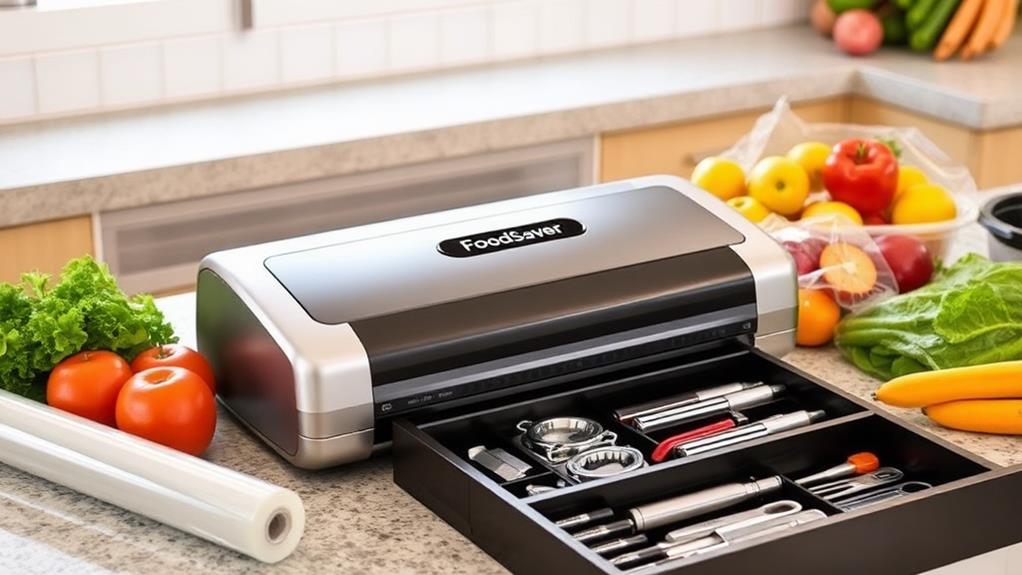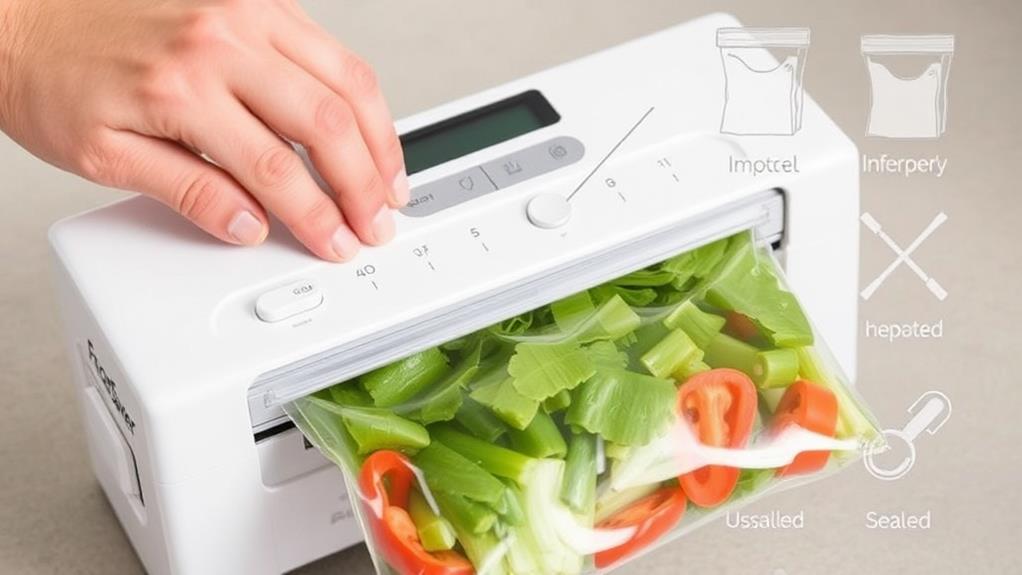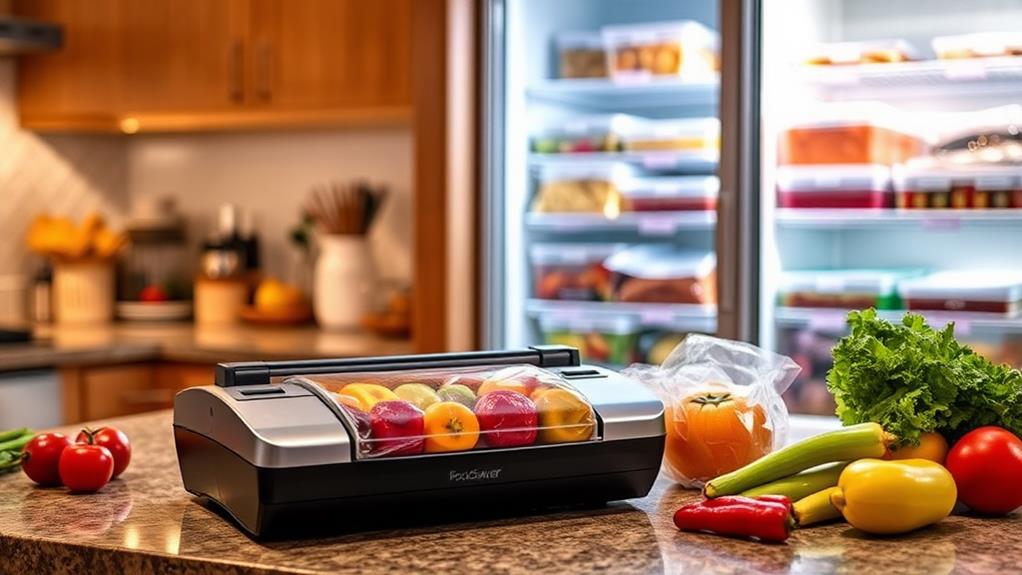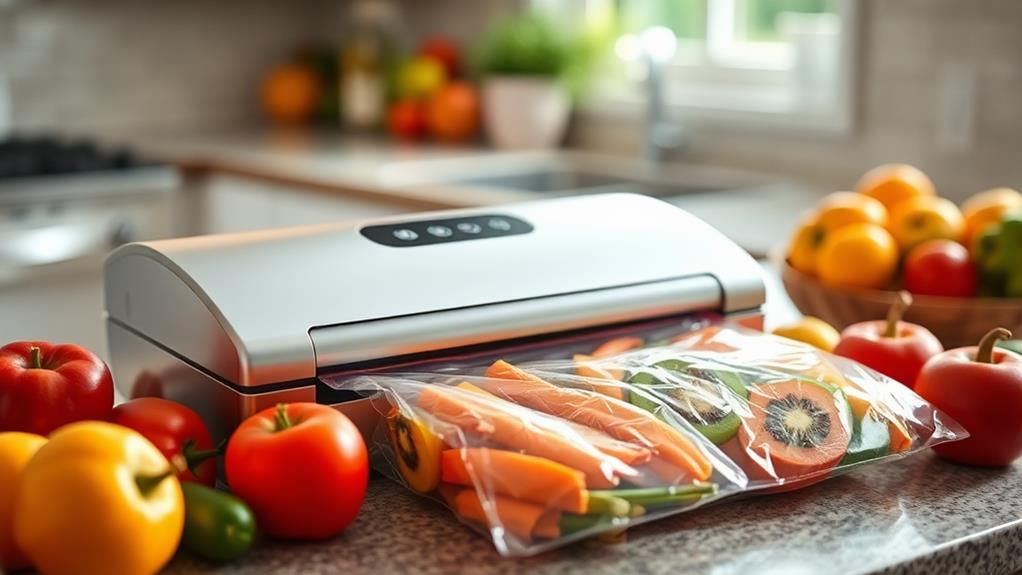To extend your food's shelf life using a Food Saver, start by selecting the right vacuum bag for your items. Place the food inside, leaving enough space at the top for sealing. Insert the bag's open end into the machine and close the lid to initiate the automatic sealing. Avoid common mistakes like overfilling or using non-vacuum-safe bags to guarantee effective seals. Regularly clean the sealing strip and check the sealer for wear to maintain performance. With these tips, you can keep your food fresh longer, and there's so much more you can explore about maximizing your Food Saver's potential.
Benefits of Vacuum Sealing
When you vacuum seal your food, you're not just preserving it; you're extending its shelf life considerably. This method can stretch the lifespan of meats from just 6 months to an impressive 2-3 years, drastically reducing spoilage and food waste.
Additionally, by adopting sustainable practices like vacuum sealing, you contribute to minimizing the environmental impact of food waste, which is essential in our eco-conscious world where sustainable delivery practices are increasingly valued.
You'll find that vacuum sealing cheese keeps it fresh for 4-8 months, compared to a mere 1-2 weeks with traditional storage. Think about how much longer your fresh fruits can last—1-2 weeks instead of just 1-6 days, making them way more usable.
Moreover, dry foods like flour and sugar can be stored for 1-2 years with vacuum sealing, preventing moisture and pest contamination that usually lead to waste.
By using this technique, you not only maintain the quality and freshness of your stored food but also save money. In fact, Americans save approximately $1,300 annually by practicing effective food preservation methods like vacuum sealing.
Foods Suitable for Sealing
Selecting the right foods for vacuum sealing can maximize the benefits of this preservation method. By understanding which items work best, you can greatly extend their shelf life and maintain their texture. Here are some foods perfect for vacuum sealing: Vacuum sealing can also help streamline your food management, similar to how expense tracking tools help entrepreneurs manage their finances effectively.
- Meats: Beef, poultry, and fish can last 2-3 years in the freezer when vacuum sealed, compared to just 6 months otherwise.
- Cheese: Vacuum sealing enhances cheese's shelf life from 1-2 weeks to 4-8 months, keeping its flavor intact.
- Fresh fruits: Extend freshness from 1-6 days in regular storage to 1-2 weeks with vacuum sealing.
- Dry goods: Items like flour, sugar, rice, and pasta can last 1-2 years when sealed, a huge improvement over the typical 6 months.
- Vegetables: Most vegetables can maintain their nutrients and texture for longer when vacuum sealed.
While vacuum sealing is beneficial for many foods, avoid sealing soft cheeses, bananas, mushrooms, and whole apples, as these don't retain their texture after defrosting.
Making the right choices will help you enjoy your vacuum-sealed foods for an extended time.
Vacuum Sealing Tools

When it comes to vacuum sealing tools, you'll find two main types: countertop sealers for more extensive tasks and handheld models for quick jobs.
These tools can greatly simplify meal prep and help in streamlining financial organization when it comes to managing food expenses.
Choosing the right vacuum seal bags is equally important, as they come in various sizes and thicknesses tailored to your needs.
Understanding these options will help you maximize your food preservation efforts.
Types of Vacuum Sealers
Vacuum sealing offers a practical solution for preserving food and extending its shelf life, and choosing the right type of vacuum sealer can enhance your food storage experience.
There are two main types of vacuum sealers to evaluate: countertop sealers and handheld sealers.
Countertop sealers are ideal for home use, providing more functionality and durability, while handheld sealers are portable and great for quick sealing tasks.
If you're looking for something more suited to commercial use, chamber vacuum sealers can handle liquids more effectively.
Here's a quick overview of the types:
- Countertop Sealers: More features and functionality for diverse tasks.
- Handheld Sealers: Convenient and portable for quick jobs.
- Chamber Vacuum Sealers: Excellent for liquids and larger quantities.
- Vacuum Seal Bags: Available in pre-cut sizes or rolls for custom sizing.
- Accessories: Jar sealers and bottle stoppers for added versatility.
When selecting a vacuum sealer, evaluate factors like freezer compatibility and the type of vacuum seal bags you'll use.
The right choice will make a noticeable difference in your food preservation efforts!
Essential Vacuum Sealing Bags
Choosing the right vacuum sealing bags can greatly impact your food preservation efforts. Using dedicated vacuum sealing bags prevents air entry, greatly extending your food shelf life compared to traditional storage methods.
Look for bags known for their durability, freezability, and microwave safety, ensuring they can endure various storage conditions without compromising your food's quality.
You'll find vacuum sealing bags in both pre-cut sizes and rolls, allowing you to customize the dimensions to fit different food items efficiently. This flexibility is essential for effective food preservation.
If filling the bags seems cumbersome, consider specialty options like Easy Fill Bags. These bags enhance sealing efficiency by simplifying the filling process and providing a more reliable seal.
Make sure the vacuum sealing bags you choose are compatible with your vacuum sealer model. This compatibility guarantees ideal performance and prevents potential issues during the sealing process.
How to Use a Food Saver
Using a Food Saver is simple and effective for preserving your food. With a vacuum sealer, you can keep food fresh and extend their freshness up to five times longer than traditional storage methods.
Additionally, incorporating tools like budgeting apps can enhance your overall financial management, allowing you to allocate funds for essential items like a Food Saver and other kitchen tools for effective savings goal setting tools for effective savings.
Here's how to get started:
- Choose the right vacuum bag for your foods, ensuring it's designed for the Food Saver.
- Place the food item inside the bag, leaving enough space at the top for an effective seal.
- Insert the open end of the bag into the machine, positioning it under the red sealing bar.
- Close the lid to initiate the sealing process; the heating element will activate automatically to create a tight seal.
- Regularly clean the sealing strip and drip tray to maintain peak performance and prevent contamination.
Common Mistakes to Avoid

When sealing food for preservation, it's crucial to avoid common pitfalls that can compromise freshness. One major mistake is overfilling vacuum bags. Always leave enough space at the top to guarantee effective sealing and air removal. If you fail to remove enough air from the bag, spoilage can occur, so double-check that the sealing process is complete and no air pockets remain.
Utilizing bill tracking tools can enhance your financial organization, just as proper sealing enhances food preservation.
Another error is using bags not specifically designed for vacuum sealing. These can lead to weak seals that jeopardize food quality. Always opt for durable, vacuum-safe bags.
Additionally, neglecting to label bags with dates can make it difficult to track freshness. Make it a habit to mark the date and contents for better organization and food safety.
Lastly, forgetting to clean the vacuum sealer can affect its sealing performance. Regularly check and clean the sealing strip and drip tray to guarantee peak function.
Maintenance Tips for Food Saver
To keep your Food Saver running smoothly, regular maintenance is crucial. By following these simple tips, you can guarantee peak performance and extend its lifespan:
Regular maintenance not only enhances the efficiency of your Food Saver but also promotes better financial management by reducing food waste, which can lead to savings in your grocery budget. This aligns with the goal of cultivating disciplined spending habits through effective management of spending and debt repayment.
- Clean the sealing strip regularly to prevent residue buildup that affects sealing performance.
- Inspect the vacuum sealer for worn or damaged parts, such as seals and gaskets, and replace them as necessary.
- Store the Food Saver in a dry area away from moisture and heat to maintain its functionality.
- Test the seal quality periodically by sealing a bag with a small amount of air and checking for air leaks after vacuuming.
- Follow the manufacturer's guidelines for maintenance and operation to maximize efficiency and durability.
Freezer Storage Tips

How can you make the most of your freezer space and guarantee your food stays fresh for longer? Start by utilizing vacuum sealing, which greatly extends the shelf life of your foods. For meats, vacuum sealing can keep them fresh for 2-3 years in the freezer, compared to just 6 months with traditional methods.
Additionally, using AI-driven tools can help you discover the best vacuum sealers and food storage options tailored to your needs, enhancing your overall food preservation strategy personalized shopping experiences.
When it comes to vegetables, don't forget to blanch them before vacuum sealing. This process preserves their color, flavor, and texture, allowing them to last 2-3 years in the freezer as well. Proper sealing is essential; it minimizes exposure to air, considerably reducing the risk of freezer burn and maintaining food quality.
Even fruits can benefit from vacuum sealing, lasting up to 1-2 weeks in the refrigerator, and freezing them can help preserve them for even longer. Before sealing, make sure your food is cooled to prevent steam build-up, which can compromise the vacuum seal and affect food preservation.
Creative Uses for Vacuum Sealing
Using vacuum sealing can really boost your meal prep efficiency, allowing you to store leftovers and bulk ingredients for longer periods.
Additionally, by utilizing high conversion rates for savings, you can make the most of your grocery purchases.
Plus, if you enjoy sous vide cooking, sealing your ingredients helps lock in flavors and guarantees even cooking.
Let's explore how these creative uses can transform your kitchen experience!
Meal Prep Efficiency
Streamlining your meal prep can transform your week, and vacuum sealing is a game changer in this process. By using a vacuum sealer, you can enhance your meal prep efficiency while reducing food waste.
Here are some creative ways to maximize your vacuum sealing:
- Pre-prep meals: Seal your meals to keep them fresh for 1-2 weeks, perfect for busy schedules.
- Chop and seal: Vacuum seal fresh ingredients like chopped vegetables and proteins, allowing for quick meal assembly.
- Marinate effectively: Use vacuum-sealed bags for marinating to guarantee flavors penetrate deeply and quickly.
- Portion control: Seal individual portions to help manage dietary goals and reduce spoilage.
- Long-term storage: Store dry staples like spices and grains in vacuum-sealed bags to maintain flavor and quality for up to 1-2 years.
With these techniques, you'll not only save time but also enjoy the benefits of fresher ingredients and less food waste.
Embrace the convenience of vacuum sealing and elevate your meal prep game!
Sous Vide Cooking
Vacuum sealing opens up a world of possibilities in the kitchen, especially when it comes to sous vide cooking. This method involves sealing food in vacuum-sealed bags and cooking it in a water bath at precise temperatures.
With sous vide cooking, you get even cooking and enhanced flavor retention, making every meal a gourmet experience.
By vacuum sealing your ingredients, you eliminate air, preventing oxidation and ensuring that flavors and nutrients are preserved throughout the cooking process. You'll notice that meats remain tender and juicy, while vegetables keep their vibrant colors and textures thanks to moisture retention.
Using a vacuum sealer for sous vide also simplifies meal prep. You can easily portion control by sealing individual servings, allowing you to cook in batches and store them in the refrigerator or freezer for later use.
The vacuum sealing process prevents water from entering the bag during cooking, ensuring that your food stays free from unwanted dilution, maintaining its intended flavor profile.
With these benefits, embracing sous vide cooking with vacuum sealing can elevate your culinary skills and enhance your meal experiences.
Conclusion
By mastering the art of vacuum sealing, you're not just extending your food's shelf life; you're also embracing a smarter, more sustainable way to enjoy your meals. Imagine opening the freezer to find perfectly preserved ingredients, ready to transform your cooking. With the right techniques and a little practice, you'll turn food storage into a simple joy rather than a chore. So, go ahead—seal the deal and savor the freshness for longer!



